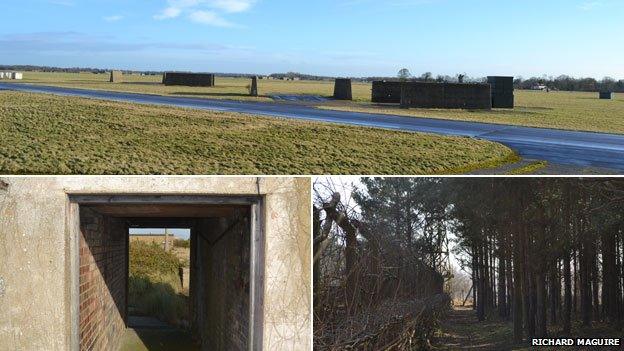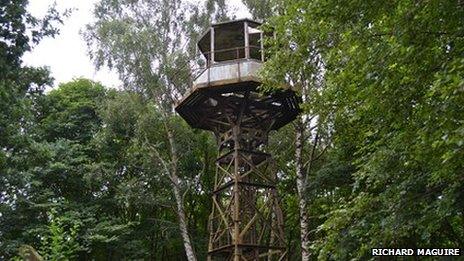Atomic bombs to monkeys: Cold War study's East Anglian stories
- Published

East Anglia was in the front line of the Cold War, which lasted from the early 1950s to the collapse of the Soviet Union in 1991
With its airbases, listening stations and nuclear weapons sites nestled in the quiet countryside, East Anglia was on the front line of the Cold War. BBC News looks at some of the stories beginning to emerge from that time of international tension.
The convoy was carrying its precious cargo between two RAF bases. Then a driver lost control of his lorry and panicked as it careered down the hill. He had good reason - what sat behind him was an atomic bomb.
The lorry crashed into a cottage and the driver feared a devastating explosion.
Former RAF policeman John Wedlake will never forget those moments deep in the East Anglian countryside in the early 1960s.
In the event, the lorry came to rest without disaster striking.
Impact of Cold War
"The elderly lady came out [of the cottage] and brought everyone a cup of tea in true British fashion," says Mr Wedlake.
At the time, East Anglia was on the front line of the Cold War, with nuclear weapon sites, listening stations, airbases and laboratories springing up next to small villages and down leafy lanes.
Dr Richard Maguire, senior lecturer in public history at the University of East Anglia, is engaged in a year-long project to assess the impact of the Cold War on the lives of ordinary people in Norfolk and Suffolk, from the early 1950s to the collapse of the Soviet Union in the early 1990s.

Barnham was one of Britain's first nuclear bomb storage facilities
"Villages and small towns faced the prospect of devastation at the hands of Soviet nuclear and conventional weapons that was unprecedented even during World War Two," he says.
"We want to try and get an inkling of what ordinary people might have thought of the Cold War.
"Received academic opinion is that people would be very against nuclear weapons on their doorstep.
"In fact, they were more concerned that the people involved in the bases were outsiders."
Urban myths
The unexploded nuclear bomb is just one of the stories unearthed by Dr Maguire during an appeal to the public for more information about the often overlooked period of international tension.
He was contacted by people who worked at the former bunker at Bawburgh - part of Britain's air defence radar system during the Cold War.
"One of the airmen was on shift on Christmas Eve and wanted to go and get a bag of crisps - code for a trip to the pub," said Dr Maguire.
"He brought drinks for his mate - nobody acknowledged them. He bought drinks to take back to the bunker. Nobody said anything to them - nobody even said Happy Christmas."
One of the most interesting things to come out of the research, Dr Maguire says, was the number of urban myths.
"In Barnham, the rumour was that they were training monkeys for the space programme," he says.
"And according to another local rumour, East Anglia has a warren of tunnels that links all the bases.
"There is a sort of basis for that rumour - there is quite an extensive network of underground cables and pipes for fuel, so people would have been seen digging the tunnels."
Back of cupboard
As part of the UEA project launched nine months ago, Dr Maguire and his colleagues have been working closely with Keith Eldred, owner of the Gorse Industrial estate near Thetford, which, in the 1960s, was the home of RAF Barnham and was one of Britain's first nuclear bomb storage facilities.
One of the buildings has been converted into a visitor centre, and a computer model of the site as it would have appeared in 1960 will be on show.
The project is also working with the National Trust at Orford Ness, the site of military tests in the 1960s, to make a computer reconstruction of the buildings there.
Dr Maguire has also been given a film used to train members of the Civil Defence Corps, whose job it was to help the region survive after an atomic attack,
It was found in the back of a cupboard at the Radar Museum at Neatishead and will be shown at Cinema City in Norwich at the end of February 2014.
The project has been funded by a £52,000 grant from the Arts and Humanities Research Council until the end of January, but will continue afterwards.
- Published12 December 2013
- Published19 November 2013
- Published30 March 2013